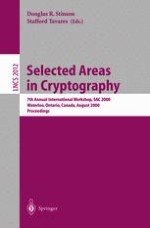2001 | Buch
Selected Areas in Cryptography
7th Annual International Workshop, SAC 2000 Waterloo, Ontario, Canada, August 14–15, 2000 Proceedings
herausgegeben von: Douglas R. Stinson, Stafford Tavares
Verlag: Springer Berlin Heidelberg
Buchreihe : Lecture Notes in Computer Science
Enthalten in: Professional Book Archive
